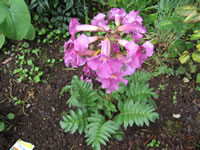How to Grow and Care for Hardy Gloxinia Plants
Incarvillea delavayi
       
Hardy Gloxinias, or Chinese Trumpet Flowers as they also sometimes known,
are old world cottage garden favorites that were under-used for decades.
In recent years though, these attractive, clump forming perennials are finally making a very well deserved comeback. |

|
Hardy Gloxinia plants produce compact 12" clumps of deep green, deeply divided, fern-like leaves.
From mid-spring until mid-summer, leafless, 12"-24" tall stems rise above the foliage to showcase clusters of 2"-3", yellow throated, magenta to pink or white, trumpet shaped blooms.
Hardy Gloxinias are excellent for borders and rock gardens and can even be grown as a house plant.
Growing Requirements for Hardy Gloxinia Plants
Incarvillea delavayi plants are hardy in USDA zones 6-10.
Hardy Gloxinias do not like wet feet in the winter, so it is imperitive that they be given adequate drainage, be grown in a raised planting bed, or in containers and brought indoors in the fall, or they can dug up after the first frost and stored in dry peat moss, in a cool dry place over winter.
These plants develop a large, fleshy tap root, so cultivate the soil deeply, and add lots of compost to the planting hole.
The soil should be sandy, well draining and slightly acidic.
|
|
Hardy Gloxinias should be grown where they will get full sun in the morning and partial shade in the heat of the afternoon.
Plant your Hardy Gloxinas 12"-15" apart, with the crown of plant just below the soil surface.
Water regularly and thoroughly during the growing season.
In colder regions, apply a heavy mulch in the fall, but remove it as soon as all danger of frost has passed in the spring.
Deadhead spent flowers regularly to prolong the blooming season.
Protect young growth from slugs and snails.
Indoors, grow your Hardy Gloxinia where it will receive full sun during the day and cool, 60° temperatures at night.
How to Propagate Hardy Gloxinias and Grow them from Seed
Hardy Gloxinia plants are somewhat difficult to divide due to their long taproots, but when necessary they can be carefully divided in the spring, immediately after flowering.
Offsets that emerge from the base of the plant can be removed and treated as softwood cuttings.
Hardy Gloxinia seeds require light for germiination, so do not cover them!
Seeds may be sown directly in the garden in late fall or early spring, for germination in late spring and blooms the following year.
Sow seeds indoors at any time, maintaining a temperature of 55°-65° in the growing medium.
Germination takes 25-30 days. |
|
Hardy Gloxinia
Incarvillea delavayi
 |
|
|
|
|
Search The Garden Helper:

